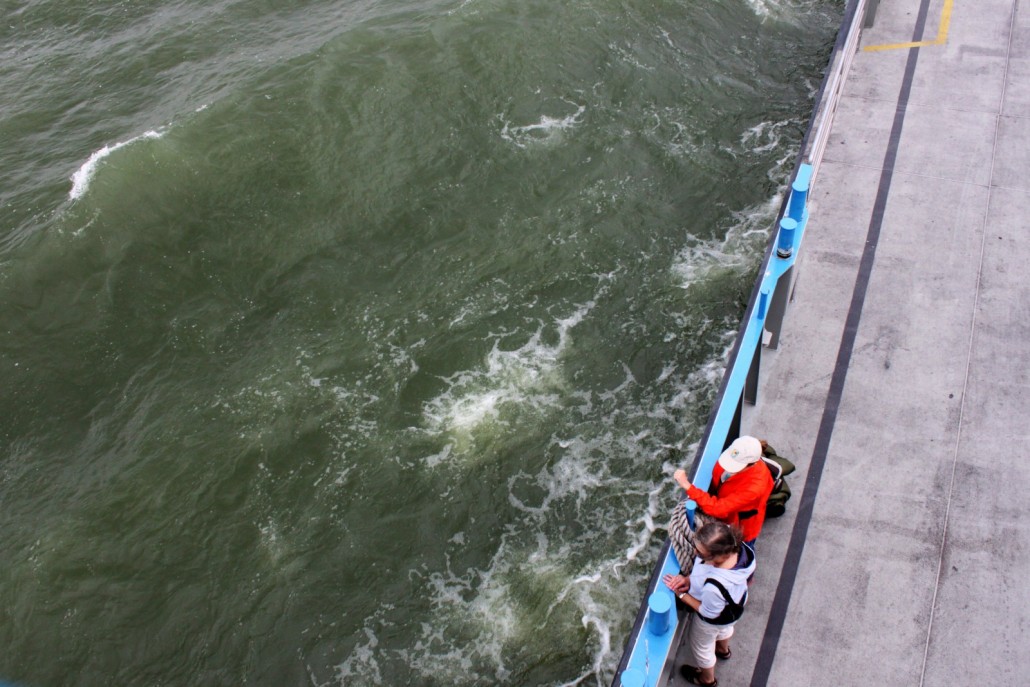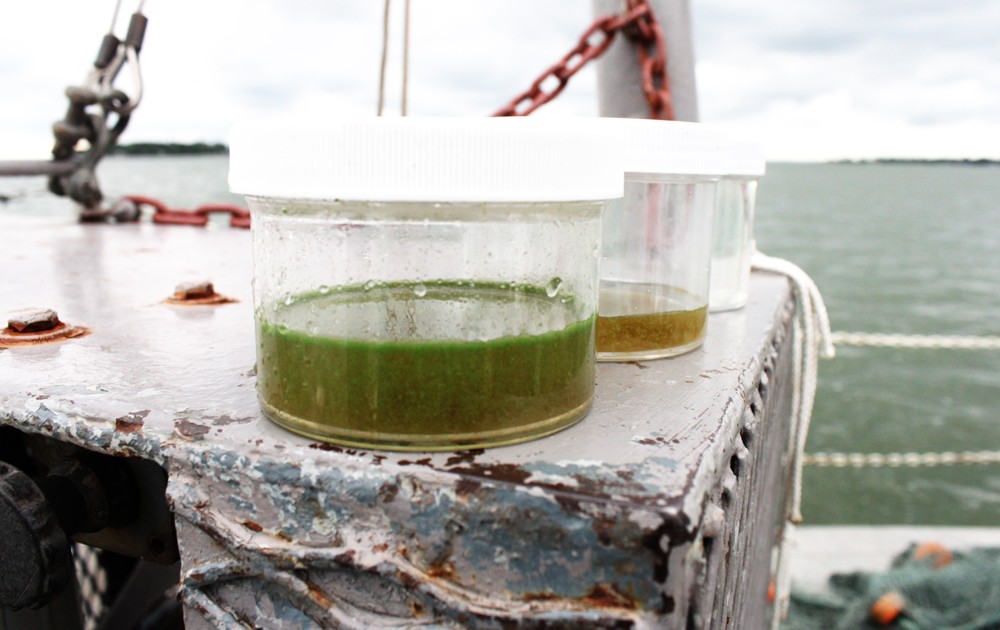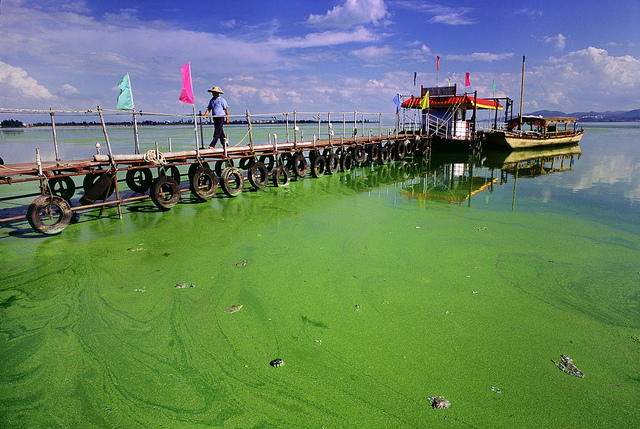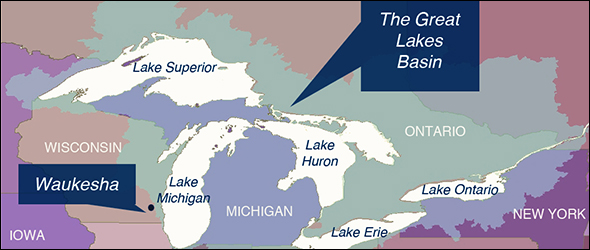Limits Set To Stop Lake Erie Algae Blooms
U.S. and Canada agree to reduce phosphorus levels 40 percent.

Blooms of algae turn Lake Erie’s water shades of jade. Last year, the bloom was the largest ever recorded on the lake. Photo © Codi Kozacek / Circle of Blue
By Codi Kozacek
Circle of Blue
The governments of Canada and the United States last month took the most significant step yet to curb the pollutants that fuel toxic algae blooms in Lake Erie. For the first time in 38 years, the two countries revised targets for the amount of phosphorus discharged into the lake and its tributaries, committing to reduce phosphorus input by 40 percent from 2008 levels.
The adoption of the new targets comes just months after the largest algae bloom on record engulfed Lake Erie last summer, and less than two years after toxins produced by the algae bloom poisoned drinking water supplies for nearly half a million people in Toledo, Ohio. It also comes on the heels of an agreement between the governors of Michigan and Ohio and the premier of Ontario, signed in August, that aims to reduce phosphorus 40 percent by 2025. Under the auspices of the binational Great Lakes Water Quality Agreement, the targets now have federal legitimacy, and each country is required to create domestic actions plans by 2018 that outline how to achieve the necessary reductions.
“The big deal here is that it is the first time that the federal authorities from both nations have gotten together and endorsed a target for phosphorus reductions for Lake Erie,” said Mike Shriberg, regional executive director for the National Wildlife Federation’s Great Lakes Regional Center in Ann Arbor, Michigan. “We have leadership from the states–from Ohio, Michigan, and from the province of Ontario—and we’ve had government reports that have talked about this as a target. But this is the first we’ve had the national authorities come together and say, hey, this is where we should be.”
New Targets For New Conditions
Scientists have long known that algae growth is driven by phosphorus, a nutrient found in fertilizers, manure, municipal wastewater, and soaps and detergents. Recognition of its role in polluting Lake Erie contributed to the regulation of factories and wastewater treatment plants under the federal Clean Water Act and the Great Lakes Water Quality Agreement in 1972. In 1978, Canada and the United States set targets for the amount of phosphorus flowing into Lake Erie each year. Since then, annual phosphorus levels have only exceeded the targets nine times. Nonetheless, after a period of improvement in the 1980s, Lake Erie’s algae blooms have gotten worse.
Researchers attribute the resurgence to a combination of changing agricultural practices and climate factors that wash soluble reactive phosphorus—a particularly potent form of the nutrient—into the lake at the right time to fuel massive algae blooms. The new phosphorus reduction goals reflect a recognition that the old targets are not working nearly well enough under these altered conditions. Instead of a blanket annual target, the new targets are tailored by phosphorus type, season, and location to address two different water quality problems in the lake:
• First, they call for a 40 percent reduction in the amount of total phosphorus and soluble reactive phosphorus flowing into Lake Erie from the Maumee River and seven other tributary watersheds during spring. This target aims to minimize the size of toxic algae blooms and eliminate the threat to public and ecological health. It includes a focus on soluble reactive phosphorus because this form of the nutrient is much easier for algae to use.
• Second, they call for a 40 percent reduction in the annual amount of total phosphorus flowing into the western and central basins of Lake Erie, limiting total phosphorus inputs to 6,000 metric tons. This target will tackle the low-oxygen dead zone in the lake’s central basin, where fish and other aquatic animals cannot survive. The old annual phosphorus target for Lake Erie was 11,000 metric tons.

New targets set by Canada and the United States aim to cut the amount of phosphorus flowing into Lake Erie by 40 percent. Phosphorus drives the lake’s harmful algae blooms. Photo © Codi Kozacek / Circle of Blue.
Timeline For Reaching Reductions ‘Up in the Air’
Unlike the state targets agreed by Michigan, Ohio, and Ontario, the federal targets do not specify a timeline for meeting the phosphorus reduction goals. The inclusion of a deadline would have made the agreement stronger, according to Shriberg, but he acknowledged that phosphorus discharges and algae blooms in Lake Erie are unpredictable in any given year. Extremely high levels of spring rainfall in the Maumee River basin, for example, can flush large amounts of phosphorus into the lake even if less phosphorus is applied to farm fields.
“This year we saw the largest ever bloom on record in Lake Erie,” Shriberg told Circle of Blue. “That doesn’t mean we applied way more phosphorus, it’s actually because we had record rains that washed a huge percentage of it off the fields. If the same amount of phosphorus is applied next year, and we have an extraordinarily dry spring and early summer, we would see a much smaller algae bloom.”
If rainstorms become more frequent and intense due to climate change, it could take longer to see any improvements in Lake Erie, or it may require even steeper phosphorus reductions to minimize algae blooms. That’s why the binational task force of scientists and water experts that created the new targets also recommended implementing an adaptive management process to revise the targets periodically.
The task force recommended using a “flow-weighted mean” along with total phosphorus loads to measure progress toward the targets. Thus the new targets focus on both the the concentration of phosphorus in the water flowing into Lake Erie as well as the ultimate number of tons. If efforts to reduce phosphorus runoff are working, researchers would expect to see lower phosphorus concentrations even in a very rainy year when loads may still be high.
“These intense rains make it harder just because it is harder to control that much water,” Laura Johnson, director of the National Center for Water Quality Research at Heidelberg University in Ohio, told Circle of Blue. Johnson and other researchers at Heidelberg University were involved in the task force that recommended the 40 percent phosphorus reductions. “That’s just a bigger challenge that essentially is going to lead to some practices not being able to be very effective, because you can’t hold back all that water when it is really raining.”

Federal, state, and industry programs are directing millions of dollars into the Lake Erie basin to help farmers reduce the amount of phosphorus washing off their fields. Photo © Codi Kozacek / Circle of Blue.
Another part of the problem is the high levels of phosphorus already available in the soil. It is difficult to predict how long it will take to draw down those legacy sources of phosphorus, Johnson said. Moreover, the way soil tests currently measure phosphorus may provide misleading results when it comes to anticipating phosphorus runoff, she added. As farmers forego traditional tilling practices in favor of no-till, the phosphorus fertilizer they apply does not get mixed very deeply into the soil. Instead, it is concentrated in the top 2.5 centimeters (1 inch) of soil the same way frosting is concentrated on the top of a cake, making it more likely to wash away during strong rainstorms. Current soil tests, which average the amount of phosphorus contained in a soil sample that is 20 centimeters (8 inches) deep, can underestimate how much phosphorus is in the top 2.5 centimeters (1 inch). To use the cake analogy, even if the same amount of frosting is included in a bite of cake, it might seem like there is less frosting if it is mixed into the cake instead of spread on top.
“Basically a soil test says how much [phosphorus] is available to the crops,” said Johnson. “Those are right within the recommended levels. What we think is happening goes back to stratification. Basically, the phosphorus has been in the wrong places, and much of it is in that top inch.”
Targeted Funding, Research Efforts
Canada and the United States have two years to develop domestic action plans to meet the new targets. The action plans will likely include a focus on agricultural best management practices, which are a suite of methods farmers can use to prevent phosphorus runoff. BMPs include installations like vegetation buffer strips to trap phosphorus before it enters streams and rivers, the use of cover crops to store phosphorus in the off-season, technology solutions like variable fertilizer application, and farming practices that avoid applying manure or fertilizer to fields that are frozen.
Scientists are researching which of these best management practices work best, and state, federal, and industry programs are already providing resources to help farmers implement them. The U.S. Department of Agriculture’s Natural Resources Conservation Service directed $US 57 million to the Lake Erie basin through federal Farm Bill programs between 2009 and 2014. Another source of funding is the federal Great Lakes Restoration Initiative (GLRI), which provided more than $US 159 million to tackle algae blooms in the Great Lakes over the past five years and seems set to continue.

Christopher Winslow, interim director of the Ohio Sea Grant program, points out different types of algae in a sample of water taken from Lake Erie in 2015. Toxins produced by certain types of cyanobacteria, commonly called blue-green algae, shut down water supplies for Toledo, Ohio in 2014. Photo © Codi Kozacek / Circle of Blue.
“Even during an election year, we feel confident that that funding will come through because it has strong bipartisan support,” Shriberg said. “In fact, the last two years President Obama has tried to reduce GLRI funding, and Democrats and Republicans in Congress have raised funding back up again. There are very few issues—I can’t think of another environmental and conservation issue—that are like that.”
“The key is making sure that funding is used efficiently and effectively, and is targeted at the areas where there is the most runoff and at the practices that will best in terms of [phosphorus] reductions,” Shriberg added. “It’s not just a problem of giving more money to agribusiness, it’s actually making sure that it is targeted effectively.”
The same holds true for research and monitoring efforts, according to Johnson. Heidelberg’s National Center for Water Quality Research has been tracking water quality in most of Lake Erie’s major tributaries, including the Maumee River, since the 1970s. But studying smaller tributary watersheds could be especially useful for tracking progress toward the new phosphorus targets, Johnson said. Researchers would be able to see changes in the water quality of a small watershed much more quickly than in a large watershed, meaning they would get faster answers about which practices are working to reduce phosphorus and which practices are not. Those answers would give farmers and water managers important insights for tweaking phosphorus reduction programs in larger watersheds.
“If we wait for results on the scale of the Maumee, it will take a long time to see changes and take a long time to change practices,” Johnson said.
A news correspondent for Circle of Blue based out of Hawaii. She writes The Stream, Circle of Blue’s daily digest of international water news trends. Her interests include food security, ecology and the Great Lakes.
Contact Codi Kozacek











Leave a Reply
Want to join the discussion?Feel free to contribute!